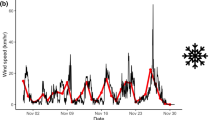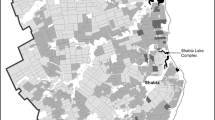Abstract
Wind farms are positioned in open landscapes and may cause loss of wildlife habitat due to disturbance, fragmentation, and infrastructure development. Especially flocking geese, swans, ducks and waders are regarded as vulnerable to wind farm development. We compared past and current displacement effects of two onshore wind farms and a line of land-based turbines on spring-staging pink-footed geese (Anser brachyrhynchus) to see if there was evidence of habituation. In one wind farm area, geese previously (1998) (Larsen and Madsen 2000) kept a distance of c. 200 m (the distance at which 50% of peak densities is reached) and they did not go between the turbines; today (2008) they keep a distance of c. 100 m, but do still not enter the wind farm area. In another wind farm, where foraging geese previously (2000) kept a distance of more than 100 m and did not enter the wind farm, they now (2008) forage between the wind turbines and keep a distance of c. 40 m to turbines. In 1998, geese kept a distance of 125 m to a line of turbines, compared to 50 m now. We conclude that geese have behaviorally adapted to changing landscapes created by wind farms. The difference in avoidance between the sites may be due to the sizes of the turbines which in this study were small in both rotor-swept area and in height compared to more recent “industry standard” of 2.5 and 3.0 MW turbines. The study points to the need for longer term studies to properly assess the impact of wind farms on wildlife, including consequent increased risks from inclement weather events of feeding, rafting, and migrating waterfowl.

Similar content being viewed by others
References
Baguette M, Van Dyck H (2007) Landscape connectivity and animal behaviour: functional grain as a key determinant for dispersal. Landsc Ecol 22:1117–1129. doi:10.1007/s10980-007-9108-4
Bélisle M (2005) Measuring landscape connectivity: the challenge of behavioral landscape ecology. Ecology 86:1988–1995. doi:10.1890/04-0923
Drewitt AL, Langston RHW (2006) Assessing the impacts of wind farms on birds. Ibis 148:29–42. doi:10.1111/j.1474-919X.2006.00516.x
Fox AD, Desholm M, Kahlert J, Christensen TK, Petersen IK (2006) Information needs to support environmental impact assessment of the effects of European marine offshore wind farms on birds. Ibis 148:129–144. doi:10.1111/j.1474-919X.2006.00510.x
Hötker H, Thomsen K-M, Köster H (2004) Auswirkungen regenerativer Energiegewinnung auf die biologische Vielfalt am Beispiel der Vögel under der Fledermäuse—akten, Wissenslücken, Anforderungen an die Forschung, ornithologischen Kriterien zum Ausbau von regenerativen Energiegewinnungsformen. Report, Michael-Otto-Institut im NABU, Germany
Larsen JK, Madsen J (2000) Effects of wind turbines and other physical elements on field utilization by pink-footed geese (Anser brachyrhynchus): a landscape perspective. Landsc Ecol 15:755–764. doi:10.1023/A:1008127702944
Madsen J (1984) Numbers, distribution and habitat selection of pink-footed geese Anser brachyrhynchus in Denmark 1980–1983. Nor Polarinst Skr 181:19–23
Madsen J (1985) Impact of disturbance on field utilization of pink-footed geese in West Jutland, Denmark. Biol Conserv 33:53–63. doi:10.1016/0006-3207(85)90004-7
Madsen J, Pihl S, Clausen P (1998) Establishing a reserve network for waterfowl in Denmark: a biological evaluation of needs and consequences. Biol Conserv 85:241–255. doi:10.1016/S0006-3207(97)00172-9
Percival S (2005) Birds and wind farms: what are the real issues? Br Birds 98:194–204
Stewart GB, Coles CF, Pullin AS (2004) Effects of wind turbines on bird abundance. Systematic Review No. 4. Centre for Evidence-based Conservation. Birmingham, UK
Stewart GB, Pullin AS, Coles CF (2007) Poor evidence-base for assessment of wind farm impacts on birds. Environ Conserv 34(1):1–11. doi:10.1017/S0376892907003554
Taylor PD, Fahrig L, Henein K, Merriam G (1993) Connectivity as a vital element of landscape structure. Oikos 68:571–573. doi:10.2307/3544927
Acknowledgments
The National Forest and Nature Agency financially supported the study in 2008. Jesper Kyed Larsen participated in the data collection in 1998. We thank an anonymous reviewer for useful comments on a draft of the manuscript.
Author information
Authors and Affiliations
Corresponding author
Rights and permissions
About this article
Cite this article
Madsen, J., Boertmann, D. Animal behavioral adaptation to changing landscapes: spring-staging geese habituate to wind farms. Landscape Ecol 23, 1007–1011 (2008). https://doi.org/10.1007/s10980-008-9269-9
Received:
Accepted:
Published:
Issue Date:
DOI: https://doi.org/10.1007/s10980-008-9269-9




